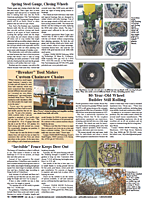2013 - Volume #37, Issue #5, Page #07
[ Sample Stories From This Issue | List of All Stories In This Issue | Print this story
]
She Turned Hard-To-Grow Luffas Into Home Business
 |
 |
But after 35 years of experimenting and growing, she’s managed to create a successful home-based business that attracts visitors from all over the U.S. and other parts of the world who are interested in taking free tours of her growing operation. They also find plenty of products in her on-farm store including sponges, gift sets and a variety of soaps, lotions and bath items that Coon makes from her homegrown herbs and other local ingredients.
Coon emphasizes that her luffa sponges are not like the imported, treated sponges with uncomfortably hard surfaces that are normally sold in the U.S. Her California-grown luffas are natural, soft and washable. Most customers use them for bathing for 3 months, and then for cleaning purposes for another 3 months. After that, Coon suggests recycling them by cutting them up and putting them in the bottom of plant pots for drainage.
When Coon officially opened her business in 1999, she planned to sell through her website and a few select shops. But when curious people started showing up at her out-of-the-way location, she realized she had the perfect business for agro-tourism.
Many visitors are surprised to discover that luffa sponges don’t grow in the ocean. Coon grows them year-round in three greenhouses that protect the plants from wind and bad weather.
“They are the most intelligent plants; they dry right on the vine,” she says. Luffas start with a yellow blossom that turns into a heavy, green zucchini-like fruit. Once the vine decides the fruits are big enough, it stops growing and shuts off food and water. The luffa turns light yellow, then brown as it dries and lightens up. When the seeds inside rattle, it’s time to pick and peel off the exterior.
While all that sounds easy enough, the luffa is very temperamental, and seeds often do not grow at all. When they do grow, luffa sponges can vary from 6 in. to 29 in.
“There’s no rhyme or reason to how they turn out,” Coon says. “It’s just like raising kids.”
Gardeners love the challenge however, and she sells packs of 15 seeds ($8). For the average gardener or even an experienced horticulturist, only one or two seeds might grow to actually bear luffa sponges. Luffa requires 120 to 140 days of frost-free weather, “and daily love and attention” to mature.
A 7-in. luffa sells for $8.
Contact: FARM SHOW Followup, Deanne Coon, The Luffa Farm, 1457 Willow Rd., Nipomo, Calif. 93444 (ph 805 343-0883; www.theluffafarm.com).

Click here to download page story appeared in.
To read the rest of this story, download this issue below or click here to register with your account number.




